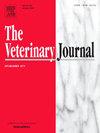Prevalence, diagnosis, treatment outcomes and immunohistochemical characterization of neoplastic disorders in reptiles presented at a veterinary teaching hospital: A cross-sectional study (2010–2023)
IF 3.1
2区 农林科学
Q1 VETERINARY SCIENCES
引用次数: 0
Abstract
Neoplasms seem to be increasingly encountered in reptile medicine. The present study investigated the prevalence, diagnosis, treatment outcome and immunohistochemical characterization of neoplasms diagnosed in reptile patients presented at a veterinary teaching hospital between 2010 and 2023. In this cross-sectional study, we analyzed the clinical records of 12383 reptiles (2549 snakes, 3386 lizards, and 6448 chelonians). Within the study population, 7261 reptiles showed clinical signs and in 130 of these cases, a histological diagnosis of neoplasm was made. A total of 134 neoplasms were identified in 27 out of 3270 chelonians (0.83 %), 63 out of 2395 lizards (2.63 %), and 40 out of 1596 snakes (2.51 %). While dermal neoplasms (n = 59; 44 %) such as squamous and basal cell carcinoma, were the most common neoplasms in lizards and chelonians, snakes were most frequently diagnosed with alimentary tract neoplasms (n = 35; 26.1 %), particularly tubular adenocarcinomas. Integumentary, reproductive and oral neoplasms carried a good prognosis following complete surgical removal, in contrast to most other neoplasms, particularly those with malignant, multicentric, or metastatic features. The results of this study elucidate the diversity of neoplastic disorders that can be encountered in reptiles within a clinical setting. In addition, similarities and differences with previously published retrospective studies originating from specialty diagnostic services and species-specific predispositions were investigated. Although histological evaluation allowed the characterization and classification of a large number of the observed neoplasms, the application of appropriate immunohistochemical protocols was indispensable towards accurate identification of several neoplasms, particularly neoplasms originating from the hematopoietic system and soft tissue sarcomas.
某兽医教学医院爬行动物肿瘤疾病的患病率、诊断、治疗结果和免疫组织化学特征:一项横断面研究(2010-2023)
肿瘤似乎越来越多地出现在爬行动物医学中。本研究调查了2010年至2023年在某兽医教学医院就诊的爬行动物患者中诊断出的肿瘤的患病率、诊断、治疗结果和免疫组织化学特征。在这项横断面研究中,我们分析了12383种爬行动物的临床记录,其中蛇2549种,蜥蜴3386种,龟6448种。在研究人群中,7261只爬行动物表现出临床症状,其中130例被诊断为肿瘤。在3270只龟类中有27只(0.83 %),2395只蜥蜴中有63只(2.63 %),1596只蛇中有40只(2.51 %),共发现134个肿瘤。皮肤肿瘤(n = 59;44 %),如鳞状细胞癌和基底细胞癌,是蜥蜴和龟类中最常见的肿瘤,蛇最常被诊断为消化道肿瘤( = 35;26.1 %),尤其是管状腺癌。与大多数其他肿瘤,特别是那些具有恶性、多中心或转移特征的肿瘤相比,皮肤、生殖和口腔肿瘤在完全手术切除后预后良好。本研究的结果阐明了在临床环境中爬行动物可能遇到的肿瘤疾病的多样性。此外,还调查了与先前发表的来自专业诊断服务和物种特异性易感性的回顾性研究的异同。虽然组织学评估可以对大量观察到的肿瘤进行表征和分类,但要准确识别几种肿瘤,特别是起源于造血系统的肿瘤和软组织肉瘤,应用适当的免疫组织化学方案是必不可少的。
本文章由计算机程序翻译,如有差异,请以英文原文为准。
求助全文
约1分钟内获得全文
求助全文
来源期刊

Veterinary journal
农林科学-兽医学
CiteScore
4.10
自引率
4.50%
发文量
79
审稿时长
40 days
期刊介绍:
The Veterinary Journal (established 1875) publishes worldwide contributions on all aspects of veterinary science and its related subjects. It provides regular book reviews and a short communications section. The journal regularly commissions topical reviews and commentaries on features of major importance. Research areas include infectious diseases, applied biochemistry, parasitology, endocrinology, microbiology, immunology, pathology, pharmacology, physiology, molecular biology, immunogenetics, surgery, ophthalmology, dermatology and oncology.
 求助内容:
求助内容: 应助结果提醒方式:
应助结果提醒方式:


